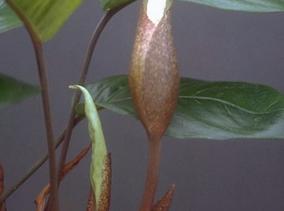Araceae
Bognera recondita (Madison) Mayo & Nicolson
SUMMARY
Plant herbaceous, evergreen, with (1-)2-4 foliage leaves. Rhizome creeping, (9-)11-18 cm long, .5-.7 cm diam., greenish, covered with reddish to dark brown and marcescent cataphylls; internodes (.5-).8-1.5(-2.0) cm long; roots many, (1.5-)2.0-2.5 mm diam., light brown, divided and second order roots thinner, .4-.5 mm diam. Longest cataphylls 13-17 cm long, membranaceous, marcescent and persistent, when young mottled like the outside of spathe, later brownish when dry. Petiole 05-)18-25(-37) cm long, .35-.40 cm diam., terete and in the distal third somewhat flattened, slightly pilose, dark green with a reddish tinge, basal sheath short 0-2 cm), weakly geniculate at apex, a dry cataphyll always covering the petiole in its lower part. Leaf blade ovate, rarely more-or-less elliptic, 17-27 cm long, (5)-6-12 cm broad, length/width ratio 3:1 to 2:1, somewhat coriaceous, upper side dark green and glabrous, underneath lighter green and veins somewhat reddish, pubescent along all veins with very short (ca . . 1 mm long [.08-.12 mm», red-brown hairs; base of blade obtuse to subcordate, apex acute to slightly cuspidate; venation parallel-reticulate, 01-)12-14 primary lateral veins pinnate (parallel to each other) on each side of the very strong middle vein and ascending towards the apex, second order veins more-or-Iess parallel to primaries (second order veins at first straight, then becoming more reticulated towards the margin), finer venation reticulate, a thin and inconspicuous collective vein present very close to the margin. Inflorescence solitary, erect, preceded by 3 to 4 cataphylls, these 2.0-9.5 cm long, the last longest and the first shortest, whitish and purple-flecked, with a mucro-like apex (ca. 2 mm long). Peduncle shorter than petiole, terete, 8-14 cm long, .35-.50 cm diam., reddish with small light spots. Spathe equalling the spadix or only slightly shorter, unconstricted, 5- 9(-10) cm long, convolute and broader in diameter 0.4-2.0 cm) in lower part, narrower in upper part (limb, .8-1.5 cm), outside reddish with smaller and larger light coloured spots, inside more-or-less cream-coloured, limb ending in a 1.5-3.0 mm long apex. Spadix (5-)7-10 cm long, .5-.7 cm diam., female zone (2.0-)2.5-3.5 cm long, laxly flowered and entirely adnate to spathe, separated from the male zone by a sparsely flowered sterile zone 1.5-2.5 cm long, male zone densely flowered, 3.0-4.5 cm long, fertile to apex (sometimes the uppermost flowers sterile). Flowers unisexual, naked; female flowers arranged in somewhat distant spirals making the cream-coloured axis of the spadix visible, staminodes absent, ovary depressed-globose, 1.5-1.8(-2.0) mm diam., cream-coloured, unilocular, ovule solitary, anatropous, .5-.6 mm long, funicle short, placentation basal; stigma sessile, discoid to subhemisphrical and as broad as ovary, yellow, papillose, occasionally somewhat sunken in the centre; synandrodes of the sterile zone usually consisting of four (sometimes 1-3) staminodes, those of lower flowers more-or-less free and only partly connate, roundish, those of upper flowers nearly completely connate and irregularly formed, sometimes all staminodes connate with a central slit, 2.0-2.5(- 3.0) mm in diam., cream-coloured; stamens of each male flower connate into a synandrium, 3-4-androus, broad to irregularly rhombic (viewed from above), truncate and flat or somewhat domed, sometimes with a central slit, 0.3-)1.5-1.8 x 1.2-1.3(-1.5) mm (viewed from above), .8-1.2 mm tall, yellowish to cream-coloured and somewhat reddish-tinged, thecae lateral on the synandrium, roundish to broadly ellipsoid-oblong, connective broad and thick, dehiscing by a very broad apical slit; pollen grains inaperturate, spheroidal to ellipsoid or ovoid, 50-60 mm long, exine smooth (psilate). Fruit and seed unknown. Chromosome number: 2n = 34; the karyotype resembles that of Dieffenbachia.

